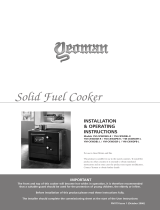
2
IMPORTANT: Stovax provide gauntlet style gloves
for the users protection from heat and any sharp
edges when using the appliance.
For your safety ensure that gloves are always worn
when opening, operating, refuelling or handling
internal metalwork.
This number is required when ordering spare parts or
making warranty claims.
The data plate is found at the rear of the appliance:
SERIAL NUMBER
Data
Plate
WARNING
Properly installed, operated and maintained this
appliance will not emit fumes into the room but
occasional fumes from de-ashing and refuelling
may occur.
Persistent fume emission is potentially dangerous
and must not be tolerated.
If fume emission persists:
• Open doors and windows to ventilate the room.
• Leave the room.
• Allow fire to burn out or safely dispose of fuel
from the appliance.
• Check for chimney blockage and clean if
required.
• Do not attempt to relight until the cause of the
emission has been identified and corrected.
• If necessary seek expert advice.
• All open flued appliances can be affected by
temporary atmospheric conditions which may
allow fumes to enter the house. Because of
this an electronic carbon monoxide detector
conforming to the latest edition of BSEN50291
must be fitted in the same room as the
appliance. The existence of an alarm must not
be considered a substitute for ensuring regular
servicing and maintenance of the appliance
and chimney system.
IF THE ALARM SOUNDS FOLLOW THE
INSTRUCTIONS GIVEN ABOVE.
GENERAL POINTS
Before installation and/or use of this appliance please read
these instructions fully and carefully to ensure that you have fully
understood their requirements.
The appliance must be fitted by a registered installer, or
approved by your local building control officer.
All local regulations, including those referring to national and
European Standards need to be complied with when installing the
appliance.
Only use for domestic heating in accordance with these operating
instructions.
You must burn only approved fuels. Do not use with liquid fuels or
as an incinerator.
Appliance surfaces become very hot when in use. Use a suitable
fireguard if young children, elderly or infirm persons are present.
Stovax offer firescreens, sparkguards and hearthgate systems
for protection. Your Stovax dealer can advise you about these
products.
Do not place photographs, TV’s, paintings, porcelain or other
combustible items on the wall or near the appliance. Exposure
to hot temperatures will cause damage. Do not place furniture or
other items such as drying clothing closer than 1m from the front of
this appliance.
WARNING: Extra fuel should not be stored on or next to the
appliance. Only keep enough fuel for immediate use nearby and
never leave the appliance unattended for long periods with any
combustible material in close proximity.
Extractor fans, cooker hoods and other heating devices placed in
the same
room or space as the appliance, may cause problems. Extra
ventilation
must be installed as per each appliance requirements.
The appliance shall not be installed with ventilating systems which
have pressure below -15Pa.
Do not obstruct inside or outside ventilation required for the safe
use of this appliance.
Do not make unauthorised changes to the appliance.
The chimney must be swept at least once a year.
Do not connect, or share, the same flue or chimney system with
another appliance.



















